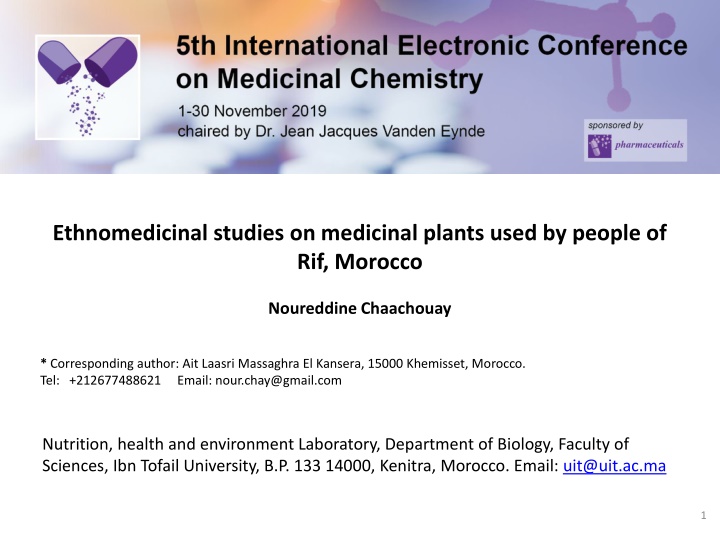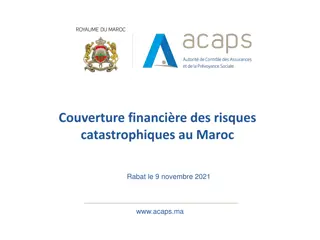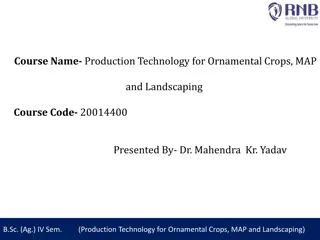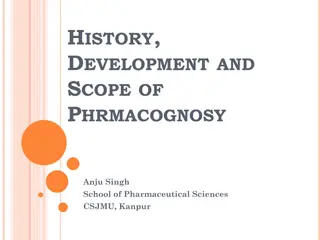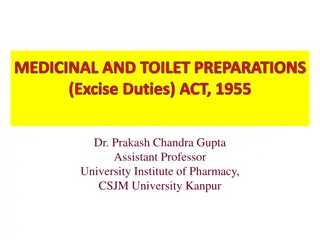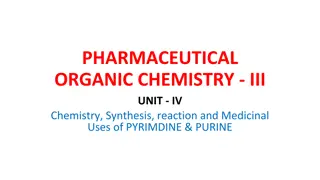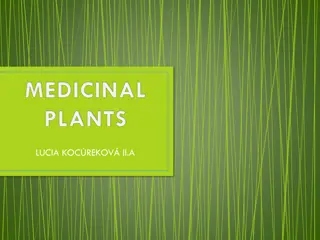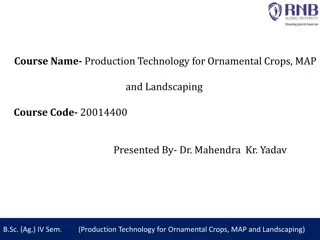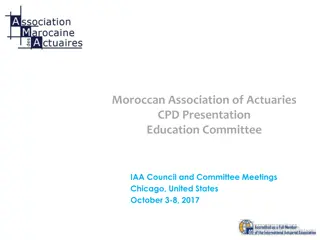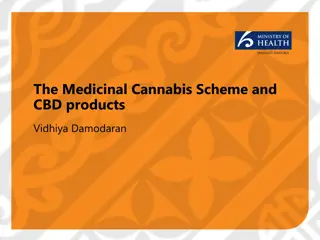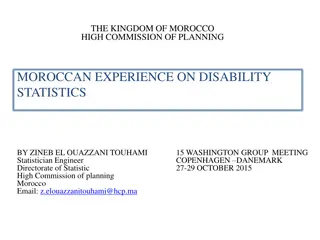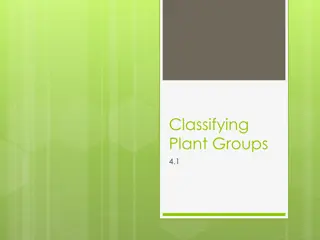Ethnomedicinal Studies on Medicinal Plants in Rif, Morocco
This study conducted in the Rif region of Morocco aimed to identify medicinal plants used by local people to treat digestive system disorders. The research documented 87 plant species from 43 families, highlighting the community's reliance on traditional ethnomedicinal knowledge. Results indicated Thymus saturejoides Coss. as a commonly prescribed species, emphasizing the significance of medicinal and aromatic plants in the region.
Download Presentation

Please find below an Image/Link to download the presentation.
The content on the website is provided AS IS for your information and personal use only. It may not be sold, licensed, or shared on other websites without obtaining consent from the author.If you encounter any issues during the download, it is possible that the publisher has removed the file from their server.
You are allowed to download the files provided on this website for personal or commercial use, subject to the condition that they are used lawfully. All files are the property of their respective owners.
The content on the website is provided AS IS for your information and personal use only. It may not be sold, licensed, or shared on other websites without obtaining consent from the author.
E N D
Presentation Transcript
Ethnomedicinal studies on medicinal plants used by people of Rif, Morocco Noureddine Chaachouay * Corresponding author: Ait Laasri Massaghra El Kansera, 15000 Khemisset, Morocco. Tel: +212677488621 Email: nour.chay@gmail.com Nutrition, health and environment Laboratory, Department of Biology, Faculty of Sciences, Ibn Tofail University, B.P. 133 14000, Kenitra, Morocco. Email: uit@uit.ac.ma 1
Ethnomedicinal studies on plants used against digestive system disorders by the people of Rif, Morocco Graphical Abstract 2
Abstract: Background: Medicinal and aromatic plants are a considerable source of active substances which are exploited in the treatment of several diseases. This study was carried out in the Rif (North of Morocco), it aimed to identify medicinal and aromatic plant used by the local people to treat digestive system diseases, together with the associated ethnomedicinal knowledge. Methods: The ethnomedical information collected was from 732 traditional healers using semi-structured interviews, free listing and focus group. Family use value (FUV), use value (UV), plant part value (PPV), fidelity level (FL) and Informant Agreement Ratio (IAR) were employed in data analysis. Medicinal and aromatic plant were collected, identified and kept at the natural resources and biodiversity laboratory, Ibn Tofail University, Kenitra. Results: During the present study 87 medicinal plant species belonging to 43 families has been documented. The most frequent ailments reported were gastric ulcers (IAR = 0.97). The majority of the remedies were prepared from decoction (42.12%). Leaves were the most frequently used plant part (PPV = 0.344) and Thymus saturejoides Coss. (UV = 0.240) was the specie most commonly prescribed by local herbalists. Conclusions: The results of this study showed that people living in the Rif of Morocco are still dependent on medicinal and aromatic plants. The documented plants can serve as a basis for further studies on the regions medicinal plants knowledge and for future phytochemical and pharmacological studies. Keywords: Moroccan Rif; Medicinal and aromatic plants; Digestive system diseases, Ethnomedicinal 3
Introduction People have long histories on the uses of traditional medicinal and aromatic plants for medical purposes in the world, and nowadays, this is highly actively promoted [1]. In all ancient civilizations and in all continents, one finds traces of this use. Morocco, by its biogeographical position, offers a very rich ecological and floristic diversity constituting a true plant genetic reserve, the mountainous regions of Rif and Atlas being the most important areas for endemism. The analysis of the Moroccan medicinal bibliography shows that the data on regional medicinal plants are very fragmentary and dispersed, due to of the few thousand plant species. Accordingly, we conducted this ethnobotanical study in the Moroccan Rif, which has a considerable lithological, structural, biological and floristic diversity. The purpose of the present investigations was to evaluate MAPs that grow in the study area with the aim to contribute to indigenous knowledge of MAPs and to analyze the results concerning the existing relationships between medicinal species and human diseases.
Results and discussion 1. Socio-demographic features of the informants Variables Catrgories Total Percentages P-values (%) 54.64 45.36 3.38 16.5 50.02 30.1 Sex Female Male <20. years 20-40 40-60 > 60years 400 332 25 121 366 220 277 0. Age 0.000 Marital status Married 550 75.2 Divorced 64 8.8 Widower 81 11 0.000 Single 37 5 Educationalstatus Illiterate Primary Secondary University Unemployed 250 - 1500 MAD 1500 - 5000 MAD > 5000 MAD 586 94 37 15 221 332 147 32 80.1 12.9 5 2 30.2 45.4 20 4.4 0.000 Income/month 0.000 5
Results and discussion 2. Quantitative analyze 2.1. Most used families and their family use value (FUV) A total of 87 MAPs species belonging to 43 botanical families were used to treat human diseases in the study area. These plants are presented in alphabetical order. For each plant listed, we give the scientific name, the family, the local name, the part used, the method of preparation adopted by the local population.. The most representative families, in terms of number of species, were Apiaceae (10 species) followed by Fabaceae and Liliaceae (7 species each), Asteraceae (6 species), Lamiaceae and Poaceae (4 species each). Based on the FUV index, The 7 most cited families are Lamiaceae (FUV = 0.106), Geraniaceae (FUV = 0.073), Lythraceae and Rhamnaceae (FUV = 0.072 each), Arecaceae (FUV = 0.070), Theaceae (FUV = 0.057) and Asteraceae (FUV = 0.051). 6
Results and discussion 2.3. Disease categories and their IAR values Informant agreement ratio (IAR) depends upon the availability of plants within the study area to treat diseases. The product of IAR ranges from 0 to 1. High value of IAR indicates the agreement of selection of taxa between informants, whereas a low value indicates disagreement. The category with the highest degree of agreement from informants was gastric ulcers related disorders (0.97). The IAR results of the study proved that diseases that were frequent in the Rif s area have the higher informant agreement ratio (values between 0.64 and 0.97). This high IAR values indicated reasonable reliability of informants on the use of MAPs species. The informant agreement values also indicated that the people share the knowledge of the most important MAPs species to treat the most frequently encountered diseases in the study area. Therefore, species with high IAR are to be prioritized for further on pharmacological and phytochemical studies [9]. 7
Results and discussion 2.2. Diversity of MAPs and their UV values The importance of MAPs was assayed by use values (UV). In the present study, UV values of cited plants ranged from 0.001 to 0.240. The most commonly used species were Thymus saturejoides Coss. (UV = 0.240), Origanum vulgare L. (UV = 0.110), Artemisia absinthium L. (UV = 0.102), Foeniculum vulgare Mill. (UV = 0.093), Ceratonia siliqua L. (UV = 0.092) and Trigonella foenum-graecum L. (UV = 0.074). The high values of UV can be explained by the fact that these plants are the best known and have long been used by the majority of informants, representing a source of reliability. In fact, many biological activity and phytochemical evaluation were carried out for these plants and these species are particularly interesting for research of bioactive compounds. 8
Results and discussion 2.4. Parts of the MAPs used 0.021 0.004 PPV Index 0.027 0.034 Leaf 0.344 0.043 Seed 0.049 Fruit 0.064 Whole plant Other combinations Bark Rhizome Root 0.118 Flower Stem 0.129 0.167 Bulb 9
Results and discussion 2.5. Methods of remedy preparations In order to facilitate the administration of the active principles of the plant, several modes of preparation are employed to know the decoction, the infusion, cataplasm, raw, maceration and cooked. In the study area. The results also showed that the majorities of remedies (89%) were prepared from decoction (42.12%) and infusion (41.33%) followed by cooked (8.67%) and raw (3.54%). The percentage of the other methods of preparation grouped (maceration, cataplasm) does not exceed 4.33%. The frequent use of the decoction can be explained by the fact that the decoction makes it possible to collect the most active ingredients and attenuates or cancels out the toxic effect of certain recipes. Ethnobotanical research surveys conducted elsewhere in Morocco showed the majority of the interviewees prepared the remedy by decoction 10
Results and discussion 2.6. Source of knowledge about medicinal plants 62.10% 18% 16% 4.20% Experience of Others Achab Pharmacist Reading 11
Conclusions Our study revealed that the local traditional healers of Rif, Northern Morocco are rich in ethnomedicinal knowledge and majority of people rely on plant based remedies for common health problems diarrhea. The survey also revealed that all the traditional healers have strong faith on ethnomedicines although they were less conscious about the documentation and preservation of medicinal and aromatic plants and ethnomedicinal folklore. Based on the results of this study, higher use value, and preference ranking scores of the recorded medicinal and aromatic plant species would empower the future pharmaceutical and phytochemical studies and conservation practices. In this connection, attention should be drawn to the conservations of traditional medicinal plants and associated indigenous knowledge in the Moroccan Rif area to sustain them in the future. 12
Acknowledgments We wish to express our heartfelt thanks to all the leaders and residents of the Rif region for their help. To all sellers of medicinal and aromatic plants (Attar). We also extend our acknowledgements to all those who contributed to the realization of this work. 13
References [1] District, Kenya , Ethnobot. Res. Appl., vol. 4, p. 061 074, 2006. [2] Bulletin officiel, Bulletin officiel, D cret n 2-15-40 du 1er joumada I 1436 (20 f vrier 2015). 2015. [3] G. J. Martin, Ethnobotany: A Methods Manual. , Earthscan Publ. Ltd, no London, p. 01., 2004. [4] M. Godron, Essai sur une approche probabiliste de l cologie des v g taux. Th se de Doctorat, USTL, Montpellier, France, p. 247 p., 1971. [5] S. K. Jain, The role of botanist in folklore research , Folklore, vol. 5, no 4, p. 145 150, 1964. [6] A. Sijelmassi, Les plantes m dicinales du Maroc, 3 me dition Fennec , Casablanca Moroc, 1993. [7] M. Fennane, M. I. Tattou, J. Mathez, et P. Qu zel, Flore pratique du Maroc: manuel de d termination des plantes vasculaires. Pteridophyta, Gymnospermae, Neuradaceae). Institut scientifique, 1999. [8] B. Vald s, Catalogue des plantes vasculaires du Nord du Maroc, incluant des cl s d identification, vol. 1. Editorial CSIC-CSIC Press, 2002. [9] G. N. Njoroge et R. W. Bussmann, Traditional management of ear, nose and throat (ENT) diseases in Central Kenya , J. Ethnobiol. Ethnomedicine, vol. 2, no 1, p. 54, 2006. J. W. Kiringe, A survey of traditional health remedies used by the Maasai of Southern Kaijiado Angiospermae (Lauraceae- 14
